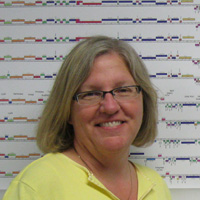Welcome to the forums at seaphages.org. Please feel free to ask any questions related to the SEA-PHAGES program. Any logged-in user may post new topics and reply to existing topics. If you'd like to see a new forum created, please contact us using our form or email us at info@seaphages.org.
Recent Activity
Holliday junction resolvase
| Link to this post | posted 29 Oct, 2025 19:24 | |
|---|---|
|
|
Hi, My student has been working on a C1 cluster bacteriophage and had the following question. Could you help? Thanks! Christine I’m working on annotating gene 101 of the C1 cluster bacteriophage Naval22. The gene is 942 bp long and encodes a 313 amino acid protein. Current evidence for Holliday junction resolvase (HJR): - PhagesDB and NCBI Blast: returns results supporting Holliday Junction resolvase call for multiple C1 cluster phages. Naval22_101 shows high similarity to JulietS_94 (e-value = 4e-8 - PSIPRED DMPmetal: predicts multiple metal cation binding sites, supporting potential HJR activity. - HHPred: shows partial similarity to HJR. Top hit is from PDB (1M0D_A), with 31.95% coverage, 98.6% probability, e-value 3.1e-7. Other hits from HHPred have < 30% coverage. Matches are only to ~ 100 amino acids in our sequence. Given the low HHPred coverage but strong similarity to confirmed C1 HJRs, is this evidence sufficient to confidently call Naval22_101 a Holliday junction resolvase? Naval22_101 protein sequence: MSVCANPECGKEFEQPNKYRTTKTCSKECRYAVSASTTKASSGRWETKVCPCGVEFQSAVNKPKTYHDWDCMMKHRQEDARASRTCENPECGKEFTYFKRQNQRTCSPECRNKVTAMKRENNYPECQTCGVSTGSYNRIYCDEHRPNRPGRKPAPRITATCLCCGEEFTRPENYPGKMKYCSNACSHRQVKKVRDKFIADLPEGAIVFHSGWEIRFWAACLRFDIPIRSYDGPDIKTSEGVYRPDFIIGKPGEERVVDVKGWLRPESEVKCREAGVHLVTKQELLRLESGDSLDAHRALLWNSGMNTHTAPLY Thanks! Haley Brancato |
| Link to this post | posted 30 Oct, 2025 01:56 | |
|---|---|
|
|
Hi Haley and Christine, I don't believe that there is enough evidence to calla function for this protein. Be sue to document this call when submitting it. Include this post in your cover sheet. Thanks, debbie |
| Link to this post | posted 30 Oct, 2025 03:45 | |
|---|---|
|
|
Thanks for your help, Debbie! Christine |
| Link to this post | posted 30 Oct, 2025 04:01 | |
|---|---|
|
|
Just another quick question, Debbie… Did you decide this because the coverage was too low? I was concerned that there was only ~30% coverage. What would be an acceptable level of coverage to support this? Also, I didn't like the fact that there were no domain hits in the CDD. Finally…I'm not sure why an emoji appeared in our previous post. It should say that the PhagesDB BLAST reported a sequence identified as a Holliday junction resolvase in Juliet with an e-value of 4e-88. Christine |
| Link to this post | posted 30 Oct, 2025 20:06 | |
|---|---|
|
|
I can answer the easy question. This board has a set of automatic emoji's (you can see then across the bottom of the text entry window) and a couple of them end in ) so you typed the evalue which ended in 8 and then the end paren. This is automatically converted to the emoji with the dark glasses. The best way to guard against these it to hit the green check mark. This will create a representation of how your post will look when posted and you can look for accidental emojis. The easiest way I know to avoid this is the add a space before the parentheses. |
| Link to this post | posted 30 Oct, 2025 21:00 | |
|---|---|
|
|
To address some of the specifics of the call of Naval22 gene 105. The RuvC and RusA resolvases are specific proteins involved in Holliday junction endonuclease activity that resolve DNA junctions. These proteins work as dimers. The term Holliday junction resolvase is not the name of any enzyme and is a generic term describing the function of the endonucleases. The protein from gene 105 in Naval22 is interesting as it appears to be composed of many different domains hitting to various endonucleases and does not fully cover any of the hits. There are hits to restriction endonucleases and helicases, etc and while gp105 does come close to covering phage T7 endonuclease I that is involved in resolving four-way DNA junctions, there are no other hits in HHpred regarding resolvase function (note this protein is named T7 endonuclease I). YacG hits are also found and this is also involved in DNA binding. Thus, a better call would be to call this a generic endonuclease as there are numerous hits to endonucleases as described above and I believe the protein most likely has some catalytic activity. Calling this as a specific DNA junction resolvase requires additional high probability hits to known resolvases (RuvC, RusA). Folding this protein in AlphaFold does not present as a structure like RuvC. In additional the great majority of calls in the pham are NKF.
RS Pollenz
|
| Link to this post | posted 31 Oct, 2025 13:09 | |
|---|---|
|
|
Thanks Rick! Christine - I would follow Rick's advice! debbie |
| Link to this post | posted 31 Oct, 2025 17:31 | |
|---|---|
|
|
Thank you all! Rick, we'll go ahead and identify it as an endonuclease. I really appreciate you explaining these details. Christine |


